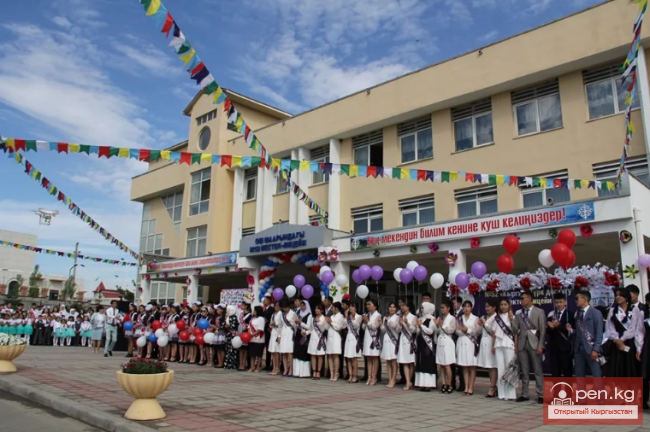
Osmonaly Sydyk uulu (1875-1940) - a scholar-genealogist, historian, and educator of the early 20th...

Arabay Uulu Eshenaly (Arabayev Ishenaly) (1882-1938) - a representative of science and culture at...

Abdykerim Sydyk uulu, Sydykov (1889 -1938) - one of the first Kyrgyz scholars who wrote works on...

The study of ethnogenetic information of nomadic tribes has been significantly contributed to by...

Belek Soltonoev Soltonkeldi Uulu (1878-1938) - historian, educator, writer, rightly recognized as...

Baytur Anvar (1938-1991), a prominent scholar and historian of modern Kyrgyz people. He was born...

It is known that in the 18th century, the Kyrgyz, although rarely, used a new writing system, as...

Education. By the time Soviet power was established in Kyrgyzstan, its population was completely...

The second half of the 19th century and the beginning of the 20th century marked an era of...

Genealogy is the “tree of life” of a person. The Turks, including the Kyrgyz, who, due to their...

Prose writer, poet, journalist S. Karachev was born in 1900—1937 in the village of Jiluu-Bulak,...

He was born in the village of Chon-Kemin, the grandson of the manap Shabdan from the Tynai clan of...

In the mid-19th century, some influential manaps, realizing the significance of the sanjyr, began...

Kalygul BAI UULU (1785-1855) - a thinker, a representative of the philosophical movement of...

Discussion Problems on the Origin of the Kyrgyz People In recent years, professional historians...

In the history of Kyrgyzstan, an interesting figure was and remains Shabdan Batyr....

“THE KYRGYZ PUGACHEV” Thus, since 1873, the struggle of the Kyrgyz people against the tyranny of...

Since the Kyrgyz did not have their own state formation during the period in question, there is no...

Aktanov Toichu Kuluntay Uulu (1910-1942) - a representative of the first generation of Kyrgyz...

Asanaliev Mayramkul Musabay uulu Graphic artist. Laureate of the Government Award of the Kyrgyz...

Kyrgyz athlete Beknazar Raimkul uulu won the gold medal at the World Sambo Championship in Russia....

Letter from Abdullabek Alimbek uulu to General Skobelev The actions of Shabdan the Hero and his...

Kyrgyz people have long been close to sports: their nomadic lifestyle was associated with the...

Actor Zhenish Mayrambek uulu received the "Oscar" award....

The new head of the Pamir Kyrgyz is 44 years old, named Azhybutu Abdylgani uulu. In Afghanistan,...

Arstanbek BOYLOSH (BUYLASH) UULU (1824—1878) — one of the prominent thinkers and poets of the...

“Fathers and Sons” Remembering what has been said, let us try to determine the scale of the...

The scientific and practical conference, held on the occasion of the 100th anniversary of the...

The Creation of an Independent Kyrgyz Khanate and Its Collapse. In the mid-19th century, the...

“Who is not with us is against us” The traditional way of life of the Kyrgyz tribal society began...

“The task of historical science in Kyrgyzstan is to research and provide a scientifically grounded...

Kasym Tynystanov (1901-1938) was born in the village of Chyrpykty in the Issyk-Kul region. He is...

Today, the Prime Minister of the Kyrgyz Republic, Joomart Otorbaev, participated in a ceremonial...

Mukhamed Dogdurov (1906-1968) was born in the village of Burkut in the Ton district of the...
Kyrgyzstani Munarbek Seyitbek uulu ranks 3rd in the updated world ranking according to World...

The national team of the Kyrgyz Republic in freestyle wrestling is conducting training camps at...

Primary Education in the City of Osh The city of Osh is not only a hub of industry but also a...

Akin, storyteller, manaschi, collector of Kyrgyz folklore I. Abdyrahmanov was born in 1888 and...

Atake Batyr was a biya - the ruler of the Sarybagysh clan, living in the Chuy Valley. To hide a...

Kebek-Uulu Nurlan Sculptor. Born on September 14, 197) in the village of Bokonbaev, Issyk-Kul...

The sanjyra, as a historical source, consists of a structure made up of legendary and several...

On October 14, the Vice Prime Minister of the Kyrgyz Republic, Elvira Sarieva, met with athletes —...

Orozbekov Abdykadir - an outstanding state and public figure, the first head of state. The name of...

At the beginning of 1925, together with the governing bodies of the Kyrgyz Autonomous Region, the...

Historical information about the size of the multi-ethnic population of the Fergana Valley during...

Altai Civilization in the Tian Shan On October 26, the two-day I International Congress-Exhibition...

Changes in the Cultural Sphere. Independence and the democratic processes occurring in public life...

Since ancient times, humans have pondered questions about the origins of everything, the emergence...